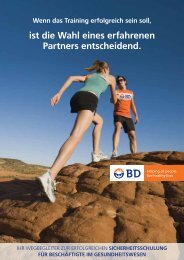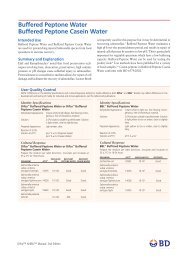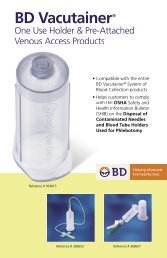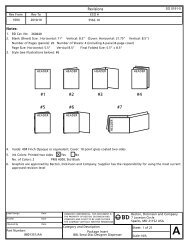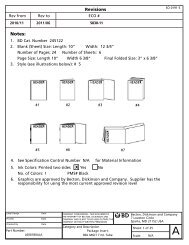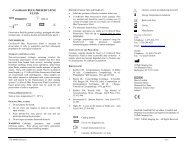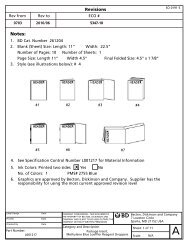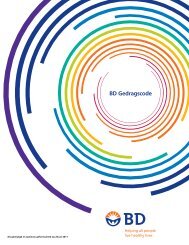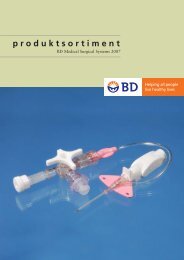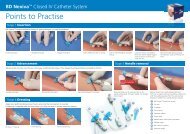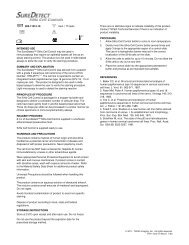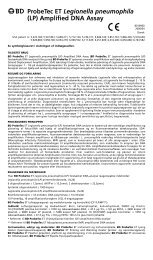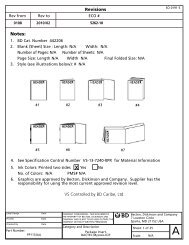BBL SXT Blood Agar - BD
BBL SXT Blood Agar - BD
BBL SXT Blood Agar - BD
You also want an ePaper? Increase the reach of your titles
YUMPU automatically turns print PDFs into web optimized ePapers that Google loves.
!<br />
<strong>BBL</strong> <strong>SXT</strong> <strong>Blood</strong> <strong>Agar</strong><br />
L007413 • Rev. 08 • July 2006<br />
QUALITY CONTROL PROCEDURES<br />
I INTRODUCTION<br />
<strong>SXT</strong> <strong>Blood</strong> <strong>Agar</strong> is a selective medium for use in the isolation and presumptive identification of group A and B streptococci.<br />
II PERFORMANCE TEST PROCEDURE<br />
1. Inoculate representative samples with dilutions of the cultures listed below.<br />
a. For the Streptococcus strains, use 5-h Trypticase Soy Broth cultures diluted to 103 –104 CFU/plate and streak for isolation.<br />
For the Neisseria strains, use 18- to 24-h Chocolate II <strong>Agar</strong> cultures diluted to 103 –104 CFU/plate and streak for isolation.<br />
b. Incubate plates at 35 ± 2°C in an aerobic atmosphere supplemented with carbon dioxide.<br />
c. Include Chocolate II <strong>Agar</strong> plates as nonselective controls for all organisms.<br />
2. Examine plates after 18–24 h for amount of growth, inhibition, colony size and hemolytic reactions.<br />
3. Expected Results<br />
Organisms ATCC Recovery<br />
*Streptococcus pyogenes 19615 For both strains, fair to heavy growth. Colonies are<br />
Streptococcus pyogenes 49117 white to gray and are surrounded by a zone of beta<br />
hemolysis which should be clearly defined within 24 h.<br />
Streptococcus agalactiae 13813 Fair to heavy growth. Colonies are white to gray.<br />
*Streptococcus mitis 6249 Complete inhibition<br />
*Neisseria subflava 14799 Partial inhibition<br />
Neisseria sicca 9913 Partial inhibition<br />
*Recommended organism strain for User Quality Control.<br />
Note: This medium is exempt from User QC testing according to CLSI M22-A3.<br />
III ADDITIONAL QUALITY CONTROL<br />
1. Examine plates as described under “Product Deterioration.”<br />
2. Visually examine representative plates to assure that any existing physical defects will not interfere with use.<br />
3. Determine the pH potentiometrically at room temperature for adherence to the specification of 7.3 ± 0.2.<br />
4. Note the firmness of plates during the inoculation procedure.<br />
5. Incubate uninoculated representative plates at 35 ± 2°C for 72 h and examine for microbial contamination.<br />
PRODUCT INFORMATION<br />
IV INTENDED USE<br />
<strong>SXT</strong> <strong>Blood</strong> <strong>Agar</strong> is used in the isolation of Lancefield groups A and B streptococci from throat cultures and other specimens. The<br />
growth of viridans streptococci, other beta-hemolytic and nonhemolytic streptococci, most Enterobacteriaceae, Neisseria species<br />
and some Pseudomonas species is inhibited.<br />
V SUMMARY AND EXPLANATION<br />
Groups A and B streptococcal infections may cause serious medical complications. Group A streptococcal infections may result<br />
in scarlet fever, rheumatic fever or acute glomerulonephritis. Group B infections may produce neonatal sepsis and meningitis. 1<br />
To aid in the detection of group A and B streptococci, chemicals (such as crystal violet and sodium azide) and antimicrobial<br />
agents (such as neomycin and gentamicin) have been incorporated into sheep blood agar. 2-4 These inhibitory agents suppress<br />
the growth of normal flora and other organisms that could mask the presence of group A and B streptococci.<br />
Gunn et al. introduced <strong>SXT</strong> Sheep <strong>Blood</strong> <strong>Agar</strong>, consisting of Trypticase Soy <strong>Agar</strong> with 5% Sheep <strong>Blood</strong> and two antimicrobial<br />
agents, sulfamethoxazole and trimethoprim, for the isolation of group A and B streptococci from throat cultures. 5 They<br />
reported that most normal flora and beta-hemolytic streptococci other than groups A and B were inhibited on the <strong>SXT</strong> agar,<br />
resulting in the recovery of 42% more group A and 49% more group B streptococci than with sheep blood agar alone.<br />
In similar studies, Mirrett and Reller and others have reported that <strong>SXT</strong> agar is more sensitive and more specific in the recovery<br />
of group A streptococci than sheep blood agar alone. 6-9<br />
VI PRINCIPLES OF THE PROCEDURE<br />
<strong>SXT</strong> <strong>Blood</strong> <strong>Agar</strong> is a primary plating medium suitable for isolating group A streptococci (S. pyogenes) and group B streptococci<br />
(S. agalactiae) from clinical specimens. Sulfamethoxazole and trimethoprim act synergistically in this medium to suppress the<br />
growth of normal flora. 5 Defibrinated sheep blood supplies the nutrients necessary to support the growth of streptococci and,<br />
simultaneously, it allows detection of hemolytic reactions. Sheep blood also inhibits the growth of Haemophilus haemolyticus, a<br />
bacterium commonly found in nose and throat cultures that is indistinguishable from beta-hemolytic streptococci. 10<br />
VII REAGENTS<br />
<strong>SXT</strong> <strong>Blood</strong> <strong>Agar</strong><br />
Approximate Formula* Per Liter Purified Water<br />
Pancreatic Digest of Casein ..............................................14.5 g Growth Factors ..............................................................1.5 g<br />
Papaic Digest of Soybean Meal ..........................................5.0 g Sulfamethoxazole ........................................................23.75 mg<br />
Sodium Chloride ..................................................................5.0 g Trimethoprim ................................................................1.25 mg<br />
<strong>Agar</strong> ....................................................................................14.0 g<br />
*Adjusted and/or supplemented as required to meet performance criteria.<br />
Sheep <strong>Blood</strong>, defibrinated ............................................5%<br />
L007413 1 of 3
Warnings and Precautions: For in vitro Diagnostic Use.<br />
If excessive moisture is observed, invert the bottom over an off-set lid and allow to air dry in order to prevent formation of a<br />
seal between the top and bottom of the plate during incubation.<br />
Pathogenic microorganisms, including hepatitis viruses and Human Immunodeficiency Virus, may be present in clinical<br />
specimens. "Standard Precautions" 11-14 and institutional guidelines should be followed in handling all items contaminated with<br />
blood and other body fluids. After use, prepared plates, specimen containers and other contaminated materials must be<br />
sterilized by autoclaving before discarding.<br />
Storage Instructions: On receipt, store plates in the dark at 2–8°C. Avoid freezing and overheating. Do not open until ready to<br />
use. Minimize exposure to light. Prepared plates stored in their original sleeve wrapping at 2–8°C until just prior to use may be<br />
inoculated up to the expiration date and incubated for recommended incubation times. Allow the medium to warm to room<br />
temperature before inoculation.<br />
Product Deterioration: Do not use plates if they show evidence of microbial contamination, discoloration, drying, cracking or<br />
other signs of deterioration.<br />
VIII SPECIMEN COLLECTION AND HANDLING<br />
Specimens suitable for culture may be handled using various techniques. For detailed information, consult appropriate<br />
texts. 15,16 Specimens should be obtained before antimicrobial therapy has been administered. Provision must be made for<br />
prompt delivery to the laboratory.<br />
IX PROCEDURE<br />
Material Provided: <strong>SXT</strong> <strong>Blood</strong> <strong>Agar</strong><br />
Materials Required But Not Provided: Ancillary culture media, reagents, quality control organisms and laboratory equipment as<br />
required.<br />
Test Procedure: Observe aseptic techniques.<br />
The agar surface should be smooth and moist, but without excessive moisture.<br />
Streak the specimen as soon as possible after it is received in the laboratory. For swab specimens, inoculate the medium by<br />
rolling the swab over a third of the agar surface and streaking the remainder of the plate to obtain isolated colonies. Stab the<br />
medium several times with the inoculating loop, in the area of heaviest inoculation, to enhance detection of beta hemolysis.<br />
Material not being cultured from swabs may be streaked onto the medium with a sterilized inoculating loop. The streak plate<br />
technique is used primarily to obtain isolated colonies from specimens containing mixed flora.<br />
Incubate the plates in an inverted position (agar side up) for 18–24 h at 35 ± 2°C in an aerobic atmosphere supplemented with<br />
carbon dioxide. Negative plates should be reincubated for an additional 18–24 h. 17<br />
User Quality Control: See “Quality Control Procedures.”<br />
Quality Control requirements must be performed in accordance with applicable local, state and/or federal regulations or<br />
accreditation requirements and your laboratory’s standard Quality Control procedures. It is recommended that the user refer to<br />
pertinent CLSI (formerly NCCLS) guidance and CLIA regulations for appropriate Quality Control practices.<br />
X RESULTS<br />
After 18–48 h of incubation, the plates should show isolated colonies in streaked areas and confluent growth in areas of heavy<br />
inoculation. Group A or B streptococci may be presumptively identified as small, translucent to opaque, white to gray colonies<br />
surrounded by zones of beta hemolysis. Gram stains, biochemical tests, susceptibility to bacitracin, utilizing Taxo A (0.04 unit)<br />
discs, and serological procedures should be performed to confirm findings.<br />
Pinpoint colonies of alpha-hemolytic, nonhemolytic or other beta hemolytic streptococci may grow in small numbers on the<br />
medium, but should not interfere with the recovery of group A and B streptococci or the interpretation of the results.<br />
Neisseria, coliforms, viridans streptococci and most non-group A or B streptococci are inhibited. Some staphylococci and<br />
Pseudomonas species may not be inhibited.<br />
XI LIMITATIONS OF THE PROCEDURE<br />
For identification, organisms must be in pure culture. Morphological, biochemical and/or serological tests should be performed<br />
for final identification. Consult appropriate texts for detailed information and recommended procedures. 15,16,18-21<br />
A single medium is rarely adequate for detecting all organisms of potential significance in a specimen. It should be recognized<br />
that organisms generally susceptible to the antimicrobial agent in a selective medium may be completely or only partially<br />
inhibited depending upon the concentration of the agent, the characteristics of the microbial strain and the number of<br />
organisms in the inoculum. Organisms that are generally resistant to the antimicrobial agent should not be inhibited. Cultures<br />
of specimens grown on selective media should, therefore, be compared with specimens cultured on nonselective media to<br />
obtain additional information and help ensure recovery of potential pathogens.<br />
XII AVAILABILITY<br />
Cat. No. Description<br />
221809 <strong>BBL</strong> <strong>SXT</strong> <strong>Blood</strong> <strong>Agar</strong>, Pkg. of 20 plates<br />
221810 <strong>BBL</strong> <strong>SXT</strong> <strong>Blood</strong> <strong>Agar</strong>, Ctn. of 100 plates<br />
XIII REFERENCES<br />
1. Facklam, R.R., and J.A. Washington II. 1991. Streptococci and aerococci, p. 238-257. In A. Balows, W.J. Hausler, Jr., K.L. Herrmann, H.D.<br />
Isenberg, and H.J. Shadomy (ed.), Manual of clinical microbiology, 5th ed. American Society for Microbiology, Washington, D.C.<br />
2. Facklam, R.R. 1976. A review of the microbiological techniques for the isolation and identification of streptococci. CRC Crit. Rev. Clin. Lab. Sci.<br />
6:287-317.<br />
3. Blanchette, L.P., and C. Lawrence. 1967. Group A Streptococcus screening with neomycin blood agar. Am. J. Clin. Pathol. 48:441-443.<br />
4. Black, W.A., and F. Van Buskirk. 1973. Gentamicin as a selective agent for the isolation of beta-hemolytic streptococci. J. Clin. Pathol.<br />
26:154-156.<br />
5. Gunn, B.A., D.K. Onashi, C.A. Gaydos, and E.S. Holt. 1977. Selective and enhanced recovery of group A and B streptococci from throat cultures<br />
with sheep blood agar containing sulfamethoxazole and trimethoprim. J. Clin. Microbiol. 5:650-655.<br />
L007413 2 of 3
6. Mirrett, S., and L.B. Reller. 1984. Comparative evaluation of medium and atmosphere of incubation for isolation of Streptococcus pyogenes,<br />
abstr. C203, p. 270. Abstr. 84 th Annu. Meet. Am. Soc. Microbiol. 1984.<br />
7. Kurzynski, T.C., and C.K. Meise. 1979. Evaluation of sulfamethoxazole-trimethoprim blood agar plates for recovery of group A streptococci<br />
from throat cultures. J. Clin. Microbiol. 9:189-193.<br />
8. Kurzynski, T.A., and C.M. Van Holten. 1981. Evaluation of techniques for the isolation of group A streptococci from throat cultures. J. Clin.<br />
Microbiol. 13:891-894.<br />
9. Kurzynski, T.A., C. Meise, R. Daggs, and A. Helstad. 1979. Improved reliability of the primary plate bacitracin test on throat cultures with<br />
sulfamethoxazole-trimethoprim blood agar plates. J. Clin. Microbiol. 9:144-146.<br />
10. Ruoff, K.L., R.A. Whiley, and D. Beighton. 2003. Streptococcus, p. 405-421. In P.R. Murray, E.J. Baron, J.H. Jorgensen, M.A. Pfaller, and R.H.<br />
Yolken (ed.), Manual of clinical microbiology, 8th ed. American Society for Microbiology, Washington, D.C.<br />
11. National Committee for Clinical Laboratory Standards. 2001. Approved Guideline M29-A2. Protection of laboratory workers from<br />
occupationally acquired infections, 2nd ed. NCCLS, Wayne, PA.<br />
12. Garner, J.S. 1996. Hospital Infection Control Practices Advisory Committee, U.S. Department of Health and Human Services, Centers for<br />
Disease Control and Prevention. Guideline for isolation precautions in hospitals. Infect. Control Hospital Epidemiol. 17:53-80.<br />
13. U.S. Department of Health and Human Services. 1999. Biosafety in microbiological and biomedical laboratories, HHS Publication (CDC), 4th<br />
ed. U.S. Government Printing Office, Washington, D.C.<br />
14. Directive 2000/54/EC of the European Parliament and of the Council of 18 September 2000 on the protection of workers from risks related to<br />
exposure to biological agents at work (seventh individual directive within the meaning of Article 16(1) of Directive 89/391/EEC). Official<br />
Journal L262, 17/10/2000, p. 0021-0045.<br />
15. Murray, P.R., E.J. Baron, J.H. Jorgensen, M.A. Pfaller, and R. H. Yolken (ed.). 2003. Manual of clinical microbiology, 8th ed. American Society<br />
for Microbiology, Washington, D.C.<br />
16. Forbes, B.A., D.F. Sahm, and A.S. Weissfeld. 2002. Bailey and Scott's diagnostic microbiology, 11th ed. Mosby, Inc., St. Louis.<br />
17. Kellog, J.A. 1990. Suitability of throat culture procedures for detection of group A streptococci and as reference standards for evaluation of<br />
streptococcal antigen detection kits. J. Clin. Microbiol. 28:165-169.<br />
18. Holt, J.G., N.R. Krieg, P.H.A. Sneath, J.T. Staley, and S.T. Williams (ed.). 1994. Bergey's Manual of determinative bacteriology, 9th ed.<br />
Williams & Wilkins, Baltimore.<br />
19. MacFaddin, J.F. 2000. Biochemical tests for identification of medical bacteria, 3rd ed. Lippincott Williams & Wilkins, Baltimore.<br />
20. Koneman, E.W., S.D. Allen, W.M. Janda, P.C. Schreckenberger, and W.C. Winn, Jr. 1997. Color atlas and textbook of diagnostic microbiology,<br />
5th ed. Lippincott-Raven, Philadelphia.<br />
21. Isenberg, H.D. (ed.). 2004. Clinical microbiology procedures handbook, vol. 1, 2 and 3, 2nd ed. American Society for Microbiology,<br />
Washington, D.C.<br />
Becton, Dickinson and Company<br />
7 Loveton Circle<br />
Sparks, Maryland 21152 USA<br />
800-638-8663<br />
ATCC is a trademark of the American Type Culture Collection.<br />
<strong>BD</strong>, <strong>BD</strong> Logo, <strong>BBL</strong>, Taxo and Trypticase are trademarks of Becton, Dickinson and Company. ©2006 <strong>BD</strong>.<br />
L007413 3 of 3



